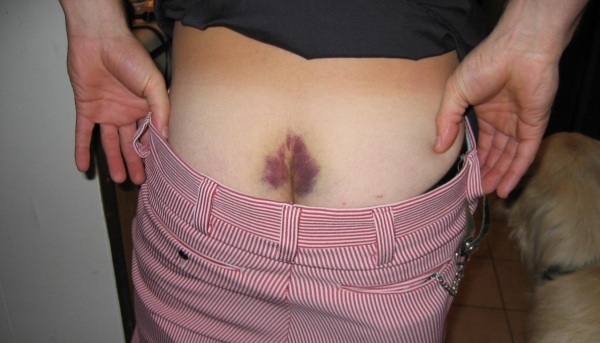In children and adult flat feet is a serious problem that needs to be corrected under the supervision of a qualified physician. As the pathological processes develop, the patient complains not only of concomitant symptoms, but also general discomfort.
Deformation of the foot negatively affects the condition of bones and joints. Timely diagnostics and correctly selected therapy are required. Otherwise, the likelihood of serious complications is high.
Record content:
- 1 Characteristics of pathology
- 2 Views
- 3 Causes and consequences
- 4 Severity
- 5 Symptoms of flat feet
- 6 Features of the inspection
- 7 Innovative diagnostic methods
-
8 Features of treatment depending on the severity of the disease
- 8.1 Drug treatment
- 8.2 Surgical intervention
- 8.3 Exercise complexes
- 8.4 Massage
- 9 Folk remedies
- 10 Orthopedic insoles
- 11 Flatfoot videos
Characteristics of pathology
Flat feet is a pathological condition in which the foot is flattened. The depreciation functions of the lower limb are impaired, painful changes occur in the spinal column and skeleton. Pathological processes affect the transverse and longitudinal arch of the foot. Deformation leads to their reduction.
Diseases of the musculoskeletal system provoke numerous complications that negatively affect the knee, hip and spine. 50% of the population face flat feet, more often it turns out to be the fair sex, since women walk in high heels.
Views
Given the area of foot deformity and the cause of the pathological condition, there are the following types of flat feet:
-
Transverse. The forefoot is flattened. Transverse flat feet are more common between the ages of 35 and 50. In most cases, the cause is heredity or weakness of the connective tissue.

-
Longitudinal. The pathological condition is characterized by a flattening of the longitudinal arch of the foot, occurs in the period of 15-26 years. Deformation of the foot occurs as a result of weakness of the musculo-ligamentous apparatus.
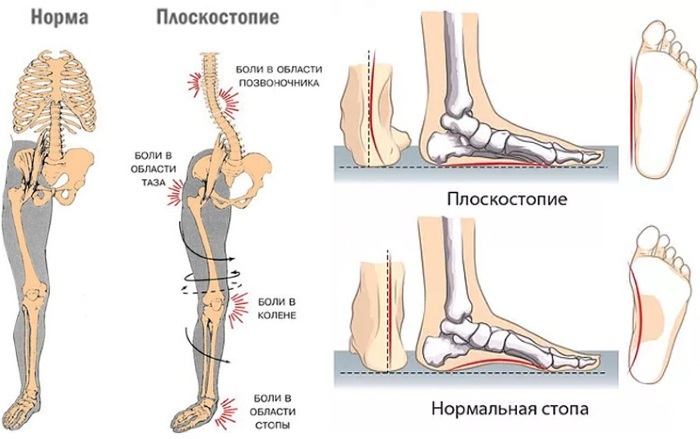
- Congenital. The cause of the disease is intrauterine defects. Congenital flat feet are rarely diagnosed.
- Traumatic. The disease is a consequence of an injury to the lower limb (fracture of the foot, ankle joint or damage to the connective tissue in the area of the tissues of the arch of the foot).
- Paralytic flat feet. The disease occurs due to paralysis of the muscles of the foot.
- Rickety. With rickets in children, the bone structure is disturbed. Under the weight of the body, the bones of the foot are deformed.
-
Static. The disease develops as a result of a heavy load on the ligamentous-muscular apparatus. Static flat feet are diagnosed in 82% of cases.
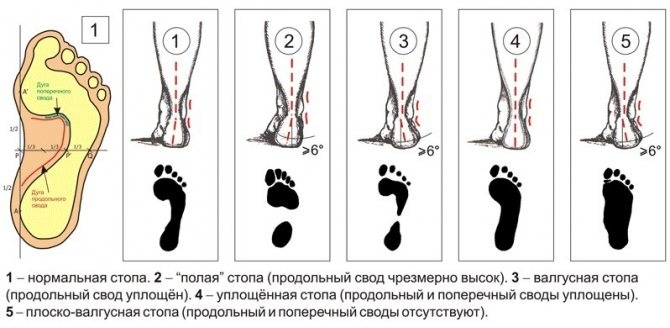
Types of flat feet
Sometimes an orthopedic surgeon diagnoses combined flat feet, when there is a flattening of the transverse and longitudinal parts of the foot at the same time.
Causes and consequences
There are numerous provoking factors against which flat feet arise:
- passive lifestyle;
- damage to the lower extremities, injuries, fractures;
- diseases (rickets, poliomyelitis, diabetes mellitus);
- weak loads on the lower limbs;
- prolonged stay on your feet;
- heavy physical activity;
- connective tissue defects;
- congenital weakness of the ligaments of the lower extremities;
- hereditary predisposition;
- extra pounds, obesity of varying degrees;
- hypodynamia;
- lack of physical activity;
- period of bearing the baby;
- wearing uncomfortable or improperly selected shoes (in most cases, a high platform or heel guarantees the development of flat feet);
- professional activity, as a result of which a person is on his feet for a long time (salesmen, surgeons, machine operators);
- age-related changes (older people often experience flat feet due to aging and a decrease in muscle strength in the legs).
Without timely medical care, pathological processes progress and complications appear in the form of arthritis or arthrosis. Diseases affect the knee or hip joint.
Flat feet (symptoms in adults appear as pathological processes and foot deformities develop) provokes the following complications:
| Name | Description |
| Inflammation of the menisci | The pathological condition is characterized by damage to the cartilage tissue. The cause may be degenerative processes or trauma, damage to the lower limb. Without timely therapy, against the background of the destruction of the meniscus, a person's working capacity decreases. |
| Coxarthrosis | Degenerative-dystrophic disease, in which the hip joint, its cartilaginous and bone structure, as well as nearby elements are often affected. Against the background of the inflammatory process, the functioning of the joint decreases. |
| Radiculitis | A pathological condition in which the spinal roots become inflamed and compressed. A common cause is diseases of the spinal column. The first and main symptom of sciatica is severe pain syndrome. |
Flat feet also provoke severe pain in the spine. The amortization ability of the foot is lost. Not only gait changes, but also posture, painful sensations appear in the back and knees.
Severity
Symptoms and degree of flat feet in adults is determined as the pathological processes progress and foot deformity: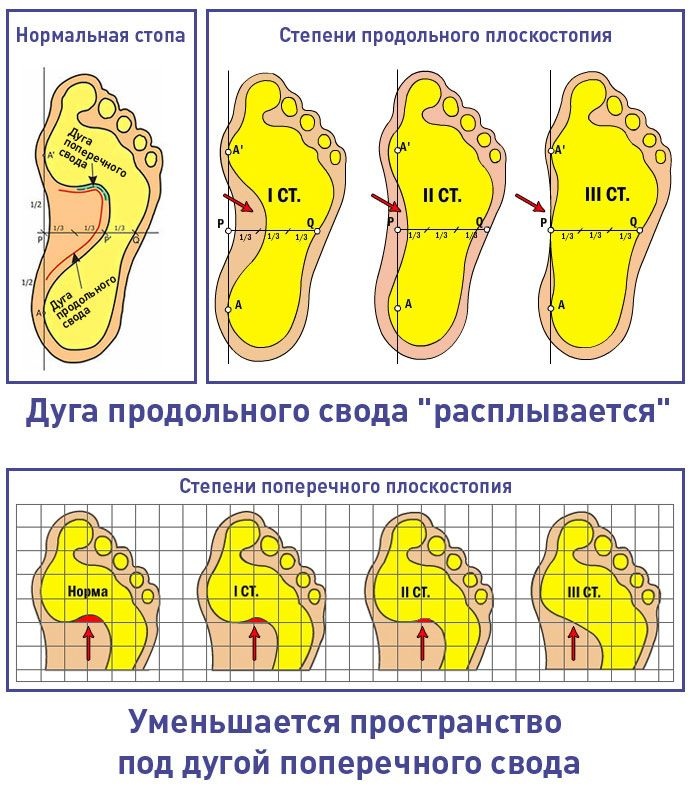
| Name | Description |
| I degree | There is no visible deformity of the foot, the changes are mild. A person is disturbed sometimes by morning swelling of the legs, weak painful sensations. Discomfort appears when wearing shoes and quick fatigue. |
| II degree | Moderate flat feet are accompanied by increased clinical symptoms. The arch of the foot disappears. The pain syndrome manifests itself more often and more strongly, passes to the ankle and lower leg. The elasticity of the muscles of the foot decreases, the gait changes. |
| III degree | The deformity worsens, as do other accompanying symptoms. The foot swells, pain syndrome is constantly present. Additionally, a person is worried about a headache. The ability to work decreases, it is difficult for the patient to overcome even small distances. There is pain in the lumbar region. |
At each stage, the symptoms of flat feet are determined by the degree of deformity of the foot. When the first violations appear, it is important to go to the hospital in a timely manner and undergo an examination.
Symptoms of flat feet
The clinical picture of flat feet will allow the orthopedist to determine the degree of development of pathological processes and prescribe the most informative diagnostic methods. In most cases, a person does not pay attention to the first signs of flat feet, attributing everything to fatigue after a hard day.

It is important to monitor the health of your feet and consult your podiatrist if you experience any of the following symptoms:
| Name | Symptoms |
| Common signs |
|
| Longitudinal flat feet |
|
| Transverse |
|
In advanced stages, flat feet are accompanied by severe pain in the sacrum and lower back while walking. Headaches also occur. It is difficult for a person to move long distances.
Features of the inspection
Flat feet (symptoms in adults worsen as the disease progresses) can be determined by a traumatologist or orthopedist. It is important to consult a specialist when the first signs or violations appear. Timely diagnostics will allow starting treatment at an early stage of the disease, stopping progressive processes and preventing complications.
Additionally, after examination, the patient is assigned the following diagnostic measures:
| Name | Description |
| Plantography | For the procedure, a special device is used - a plantograph. The print of the sole of the foot is examined. |
| X-ray | The most informative diagnostic method, with the help of which the doctor determines the degree of foot deformity. |
| Podometry | The obtained physiological parameters of the foot make it possible to determine the index of the longitudinal and transverse arch (the results are indicated as a percentage). |
| Podography | The examination examines and evaluates a person's gait. The center of gravity is established in relation to the midline and its offset. Podography reveals not only flat feet, but also the degree of curvature of the spine. |
| Electromyography | The study helps to assess the condition of muscle tissue. Registration of bioelectric activity will allow to establish the degree of flat feet. |
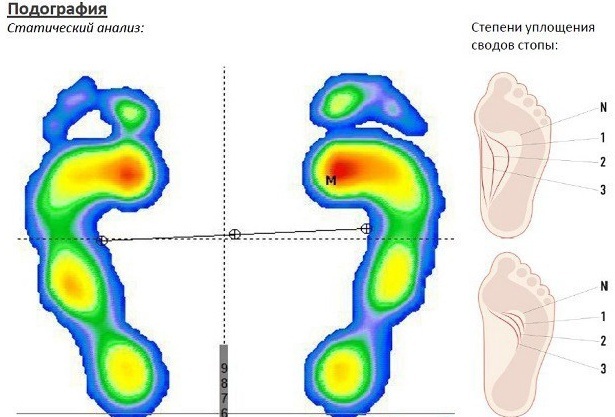
It is also important to differentiate the disease, since many pathologies of the lower extremities are accompanied by similar clinical symptoms.
Innovative diagnostic methods
For the diagnosis of flat feet, the latest computer technologies are additionally used. They allow you to get the most accurate results for the correct diagnosis.
Innovative examination methods are carried out using the following instruments:
- computer complexes (SEMJA, BIODEX);
- dynamometric platforms with numerous components (VISTI, Kistler);
- digital equipment for photographing and scanning the footprint.
The data obtained after the examination are processed by computer programs. The orthopedic surgeon receives the most accurate results, which are necessary not only for making an accurate diagnosis, but also for drawing up a treatment regimen.
Features of treatment depending on the severity of the disease
It is impossible to completely get rid of flat feet, especially if the disease is found at a late stage of development. The doctor will select a treatment regimen to stop the progressive pathological processes.
The specialist prescribes medicines, massage, folk remedies and exercises, taking into account the results of a comprehensive diagnosis and the condition of a person. You cannot take medications on your own, since serious complications can be provoked.
Drug treatment
Medicines are prescribed by an orthopedic doctor, taking into account the accompanying symptoms in a person and the results of research. It is important to adhere strictly to dosages, since many drugs provoke side effects.
| Drug group | Name | Application |
| Analgesics | Flugalin, Indomethacin | Medicines reduce painful sensations. The drug is recommended to be taken orally 1 capsule 1 time per day, preferably in the evening after meals. |
| Topical products | Dolgit, Voltaren | Ointments, creams and gels are applied to the foot area. The agent is rubbed into the affected area with light massage movements 3-4 times a day until completely absorbed. Given the area of the lesion, the cream is applied in a line of 4-10 cm. The course of treatment is determined by the severity of the patient's condition and averages 2-3 weeks. |
In addition to medications, patients are advised to attend physiotherapy procedures that enhance the therapeutic effect (electrophoresis, phonophoresis).
Surgical intervention
Flat feet (symptoms in adults will help the orthopedist to establish the degree of foot deformity) requires surgical treatment if there is no positive dynamics after drug therapy. The same applies to a condition when serious complications of the disease have appeared.
There are numerous techniques, one of which the surgeon chooses, taking into account the patient's condition and the degree of foot deformity. Correctly planned surgery will prevent recurrence of the disease.
Exercise complexes
Flat feet (symptoms in adults at an early stage of the disease will help to go to the hospital in a timely manner) is treated with complex methods and involves the implementation of physiotherapy exercises.
Exercise is important to do regularly in order to achieve positive results. A set of classes will help you choose a physiotherapist, taking into account the condition of a person and the individual characteristics of his body.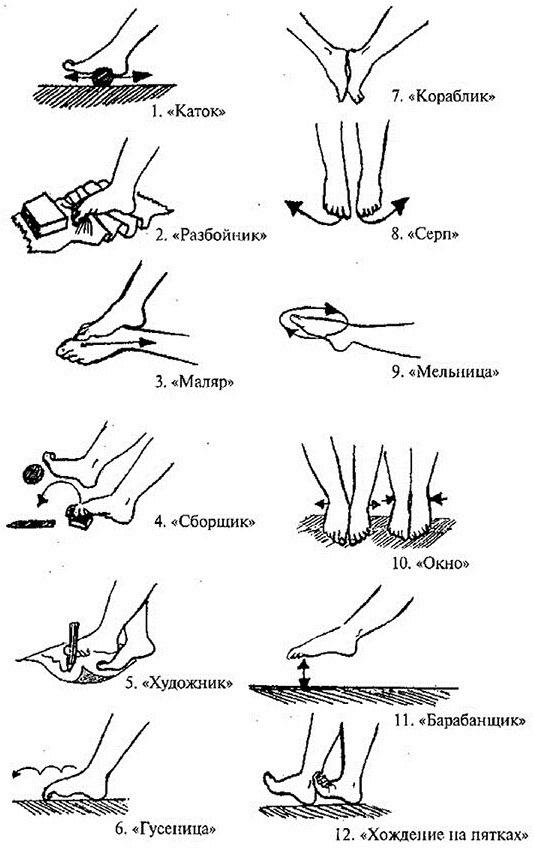
Some exercises can be performed while sitting at a table, but there are also activities that take a little time:
- Sitting on a chair, you need to spread your knees and connect your feet. In this position, press the socks together, and spread and connect the heels in turn.
- Pick up a round gymnastic stick. Stand on it with your feet and, in this position, perform toe squats.
- Sitting on a chair, put a paper napkin on the floor. With the fingers of the lower extremity, collect the napkin without lifting the heel off the floor.
- It is recommended to paint with your toes using finger paints or pencils.
- It is also recommended to grab any objects off the floor with your toes.
During physical warm-up, it is recommended to walk on heels, toes, outside and inside of the feet. You can walk with your toes raised or tucked in. In a supine or seated position, it is recommended to rotate the feet in different directions.
Massage
A targeted effect on the feet of the lower extremities will help reduce the symptoms of flat feet. Also reduce the intensity of pain, improve blood circulation, restore muscle tone. The massage can be performed independently at home, but it is also recommended to visit a qualified specialist 1-2 times a year.
The procedure must be carried out at all stages of flat feet. At home, massage is recommended using special rugs, balls, rollers. After each procedure, fatigue in the legs decreases, and material metabolism improves.
Folk remedies
Prescriptions of healers and healers can be used in the complex therapy of flat feet, but after consultation with the attending orthopedic doctor. It is important to consider the likelihood of an allergic reaction to the components used or individual sensitivity.
Effective folk remedies for flat feet:
| Name | Recipe | Application |
| Peppermint | Pour 100 g of dry grass with boiling water (500 ml). Insist for 30 minutes and drain. | It is recommended to add the finished broth to warm water and steam your legs for 15-20 minutes. |
| Compress | Mix the iodine solution (3%) and lemon juice in equal proportions. Add 2 aspirin tablets, previously crushed into powder. Mix all components well. | The prepared gruel must be laid out on the affected area of the lower limb, covered with plastic wrap and wrapped in a woolen scarf. It is recommended to do the compress for 3 days in a row, then take a break for 7 days and continue the treatment. |
| Oak bark | Pour oak bark (200 g) with hot water (1 l). Insist for 30-40 minutes and drain. | Add the resulting broth to a warm bath for steaming feet. |
| Immortelle tincture | Dry the flowers of the plant in the oven, add vodka or alcohol. It is recommended to infuse the resulting mass for 3-7 days. | It is necessary to lubricate the feet with the finished tincture. |
Foot baths can be done after massage treatments. First, steam your feet in hot water, then place them in cold water. The procedure should be performed 2-3 times. It is recommended to add sea salt, herbal decoction or baking soda to the water.
Orthopedic insoles
In the early stages of flatfoot development, patients are advised to use orthopedic insoles. They will help alleviate the human condition and slow down the development of pathological processes. In difficult situations, the patient is advised to make custom-made orthopedic shoes. It is not recommended to constantly wear insoles for prevention, as it can weaken the muscles.
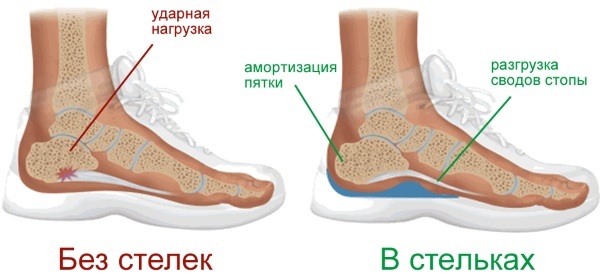
Correctly selected orthopedic insoles perform the following functions:
- Supports the longitudinal and transverse arch of the foot.
- Increases stability when walking or standing still.
- Improves the general well-being of a person.
- Reduces fatigue and discomfort after long periods of walking.
- Improves blood circulation in the legs.
Orthopedic insoles also reduce stress on the spine and joints. They help to properly distribute the load on the muscles.
A condition such as flat feet in adults is not dangerous to health, but people with such a disease must undergo treatment in order to prevent serious consequences.
The first symptoms will help to determine the pathological processes in the early stages, with which it is important to consult an orthopedist in a timely manner. It is impossible to stop the disease on your own, you can only aggravate the state of health.
Flatfoot videos
Flatfoot myths:

